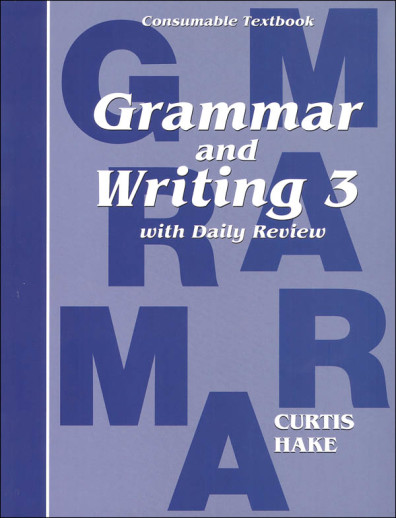We use cookies to make your experience better. To comply with the new e-Privacy directive, we need to ask for your consent to set the cookies. Learn more.
Grammar and Writing 3 Consumable Textbook
The Student Textbook can be used either as a consumable (writing directly in the book) or a non-consumable (writing sentences out on separate paper). 111 lessons thoroughly cover types of sentences, parts of sentences, parts of speech and include diagramming. Periodic lessons review spelling rules and provide comprehensive instruction in capitalization and punctuation. A "Grammar Meeting" is conducted as part of each lesson. These are scripted dialogs between teacher and student and are designed to strengthen listening skills, practice correct word usage, develop effective speaking habits, and introduce root-based vocabulary studies. Daily teacher-guided lessons include the Grammar Meeting, grammar instruction (liberally utilizing examples), diagramming (again, with examples), and exercises; practice sets, more practice sets (sometimes), and a review set. The Text includes a complete index of topics.
Grammar and Writing is a language arts series for middle school students.
Contents:
- Comprehensive English language curriculum
- Grammar, writing, spelling, and vocabulary development
- Core Knowledge content of other subject areas, including history, geography, science, and literature, as recommended by E. D. Hirsch embedded in the curriculum.
- Exceeds state standards in the areas of language and writing.
Features:
- Organized like the Saxon® Math textbooks Stephen Hake co-authored, with incremental development of the subject and continual review of concepts and skills
- Hardcover student edition with consumable writing exercises and reproducible practice sheets and tests
Target Population:
- Written to conform to grade-level standards
- Successfully field tested with fourth through eighth grade students
- Appropriate for older students and adults
Expanding the scope and sequence of the Grammar and Writing program to third grade and written by its original authors (Mary/Curtis Hake), this course provides a comprehensive introduction to both grammar, usage, and mechanics as well as an excellent introductory writing course. Employing all the familiar Saxon methodologies; incremental lessons, spiral teaching, and continual review while also following in the tradition of easy-to-implement lessons and thorough instruction this new grade level lives up to its heritage. At this level, instruction involves daily teacher-student interaction coupled with independent student work. Course components include a Textbook, a Teacher Guide, and a Writing Workbook. Textbook - 488 pgs, pb. Teacher Guide - 312 pgs (plus masters), pb, perforated, three-hole punched. Writing Workbook - 92 pgs, pb, perforated, three-hole punched. ~ Janice
The Student Textbook can be used either as a consumable (writing directly in the book) or a non-consumable (writing sentences out on separate paper). 111 lessons thoroughly cover types of sentences, parts of sentences, parts of speech and include diagramming. Periodic lessons review spelling rules and provide comprehensive instruction in capitalization and punctuation. A "Grammar Meeting" is conducted as part of each lesson. These are scripted dialogs between teacher and student and are designed to strengthen listening skills, practice correct word usage, develop effective speaking habits, and introduce root-based vocabulary studies. Daily teacher-guided lessons include the Grammar Meeting, grammar instruction (liberally utilizing examples), diagramming (again, with examples), and exercises; practice sets, more practice sets (sometimes), and a review set. The Text includes a complete index of topics.
The Writing Workbook is consumable and provides 21 lessons covering sentence and paragraph construction; persuasive, expository, narrative, descriptive, and chapter summaries (literary response) with an emphasis on the writing process. The Hake/Saxon step-by-step approach is evident and effective in these straight-forward lessons. One of my favorite methodologies for developing strong and interesting sentences, sentence combining, is utilized throughout the lessons. Writing lessons and tests are scheduled after every fifth grammar lesson (starting after Lesson 10).
The Teacher Guide provides overall lesson scheduling information and daily lessons including scripts for the Grammar Meetings. Answer keys for practice, more practice, and review sets from the Student Text as well as the writing lessons are also provided. Lastly, there are reproducible Test Masters and More Practice Masters (along with answer keys) in this teacher book.
| Product Format: | Paperback |
|---|---|
| Grade: | 3 |
| Brand: | Hake Publishing |
| Author: | Curtis Hake |
| ISBN: | 9781935839293 |
| Length in Inches: | 11.1875 |
| Width in Inches: | 8.625 |
| Height in Inches: | 1 |
| Weight in Pounds: | 2.15 |
It maybe puts too much into one package: phonics review, mechanics review, dictionary use. But maybe we are used to coddling our children. She does just fine with it despite me thinking it is a lot.
No, it doesn't. It is only the student textbook. It is really nice that you can write in it. You will have to get the homeschool bundle to get all three books.
The teacher book, writing book, and consumable textbook (this is the only year they offer the consumable textbook, after this the writing book has some extra lesson practice sections and is the only consumable text of the trio) are three separately bound texts.
We've used Saxon for math for a long time. And I have a few of the grammar books. There is a lot of overlap between years, and honestly it is intense. But, also it is very complete, which is why I find myself returning to it over and over. But I use one text book for 2 or more years. It's just too much for one year. You'll learn a lot of grammar concepts yourself from this text, I promise!
Hope this helps, good luck!


School
Saxon Grammar is intensive but effective.
Love it!
Love this curriculum!!